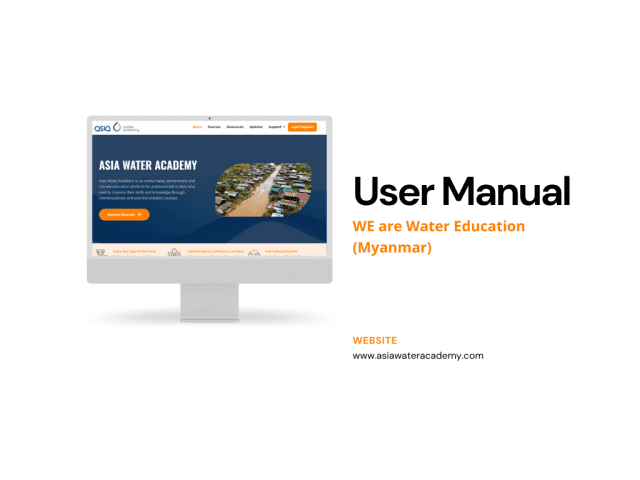The environment is made up of elements, both living and non-living, such as air, water, minerals. It is known worldwide that water is a particularly important natural element because it is essential for sustaining life and it also supports lives. The water is home to millions of species, from the smallest organisms to blue whales that can measure up to 30 meters long and weigh up to 200 tons. Changes in water conditions such as flow, salinity, and temperature affect the species that live there.
The way water flows is changing slowly every day. The construction of dams provided people with a reliable source of water, but it disrupted the natural flow cycle needed for rivers’ and wetlands’ health. Deteriorating sanitary conditions in rivers and wetlands has an impact on people. Poor water quality in rivers can affect the water supply of towns and cities, industry, agriculture and most importantly health. Water for the environment is essential for maintaining a healthy, productive and resilient river system to benefit plants, animals and humans. It is clear that the path to the sustainable use of water and its resources is due to all the important elements of a circular economy through efficiency, innovation, waste prevention, reuse and recycling. In fact, saving one resource, such as water, saves all other resources.
Water and Ecosystem
An ecosystem is a geographical area in which plants, animals, other organisms, weather and landscape together form the bubble of life. Ecosystems can be very large or extremely small. Every element of an ecosystem is directly or indirectly depending on each other element. For example; temperature changes in ecosystems often affect the plants that grow there.
Water connects and sustains all ecosystems on Earth. The role of water in an ecosystem is diverse and there would be no life on this planet without water. The primary reason for water in an ecosystem is to provide life support to communities. As the most important nutrient, water helps transport oxygen, minerals, nutrients, and waste products and also forms cells. Water plays an important role in plant production as some seeds are dispersed with water. It provides a habitat for a variety of plants and animals which is important for photosynthesis.
The physical state of a body of water strongly influences the chemical and biological processes that occur in it. The chemical types present in water are strongly influenced by the environment in which the water is present and the chemical reactions that occur. When humans alter ecosystems without maintaining the balance of nature, the life cycle of ecosystems can become one-sided and destroy the delicate balance needed to sustain societies. Some species may die and others can thrive, but eventually, the symbiotic relationship may break down and the ecosystem dies.
Water and Sanitation
Billions of the poor have trouble getting access to safe water sources and they spend time getting stuck in queues, travel long distances to find water sources and use polluted water which addresses their health impacts. Millions of people get sick or die every day and it was caused by unsafe water and a lack of basic sanitation. Diseases kill more people each year than all forms of violence, including war. Access to clean water is a basic human right.
More than 4 out of 5 Myanmar citizens have access to clean water and 3 out of 4 have good toilets. However, in many rural areas where most people live, this figure is among the lowest in Asia. Diarrhea is one of the most common seasonal diseases in Myanmar and occurs mainly during the summer and rainy season (Lwin & Putra 2018). Diarrhea causes 18% of deaths in children under 5 years of age in Myanmar (Camp 2017). Diarrhea can be prevented by promoting clean water, toilets and hygiene. According to an overview study in developing countries (Fewtrell et al. 2005), diarrhea episodes can be reduced by improving water supply, sanitation, and toilets. In addition, domestic water treatment and safe water storage can reduce diarrhea rates by 39%.
Clean water changes almost everything. Safe water is not only a prerequisite for good health, it contributes to livelihoods, education and dignity and helps create resilient communities living in healthy environments. Access to clean water is closely linked to poverty. Water scarcity, harsh water quality and inadequate sanitation adversely affect food security, livelihood options and educational opportunities for poor families around the world, especially for women and girls where they could use their energy on learning vocational and professional education for a better future.
Water and Food System
Water is essential to our daily lives and is at the heart of food security. Think about the glass of water we drink with our meals. There’s even a famous quote among Myanmar people that humans can “live seven days without rice, and one morning without water”. Crops and animals need water to grow. Agriculture requires a large amount of water for irrigation and good quality water for different production processes. Myanmar’s fertile soil and abundant water sources are well known in Southeast Asia. Myanmar’s agricultural conditions are said to be among the best in Asia. From fruits to vegetables, from rice to legumes, almost anything can be grown in this country.
Myanmar has an agricultural economy where society and agriculture depend on rainfall. Heavy rains cause flooding, and lack of rainfall causes drought, which adversely affects agricultural production. A decrease in the income of the agricultural sector can have many negative effects not only on the income of individual farmers, but also on the national economy.
Nature-based solutions
The climate crisis is getting more terrible. Sea levels are rising and the risk of erosion, flooding and storms is increasing in coastal areas around the world. Heat waves are more frequent, fueling wildfires, stressing wildlife habitats, and promoting droughts that threaten crop or water security. However, people are finding the best solution to protect against climate crisis.
Each of us has a duty to protect our earth start by doing small actions like reduce using single-use plastic or switching buses and bikes for transportation. Nature itself plays a very important role too. There is increasing evidence that nature-based solutions (natural systems or processes used to achieve social goals) can make a significant contribution to mitigating climate change and its effects. Nature-based solutions are actions that protect and sustainably manage and restore natural ecosystems, addressing social challenges such as climate change, human health, food and water security, disaster risk reduction, human well-being and biodiversity.
For example, a common problem is the flooding of coastal areas as a result of storm surges and coastal erosion. This problem, which has traditionally been dealt with through man-made (grey) infrastructure such as sea fences and dams, as well as flooding in coastal areas, can also be dealt with through measures that use ecosystem services such as afforestation. Mangrove forests along the coast are important not only for the sustainability of fisheries, but also for providing a natural protective barrier against erosion and storms. By providing wood and food resources, vast amounts of carbon can be stored.
References
- The environment: Clean water is life, health, food, leisure and energy I Openaccessgovernment
- Environment I water.ca.gov
- What Are Some Similarities Between Marine & Freshwater Ecosystems? I Sciencing
- Ecosystem I National Geographic
- Water and health I IWA
- Water and sanitation I Oxfam
- Water, sanitation and hygiene (WASH) I WHO
- WATER INTERACTIONS WITH ENERGY, ENVIRONMENT,FOOD, AND AGRICULTURE I eloss.net
Written by Hnin Wut Yee San, an intern at The Water Agency.





